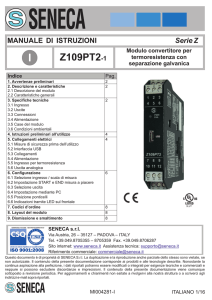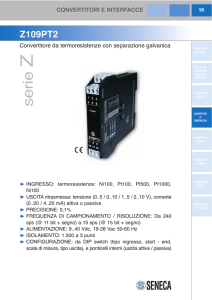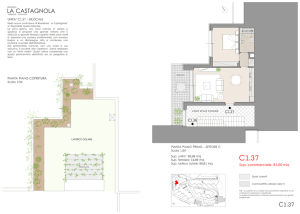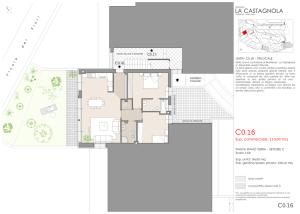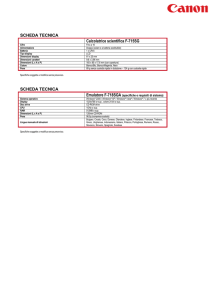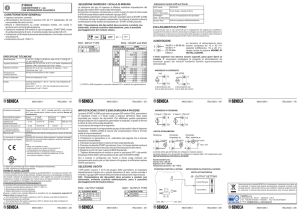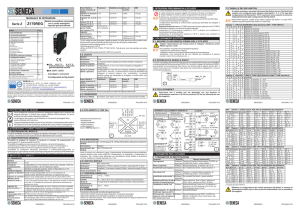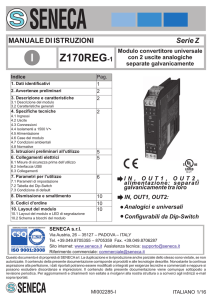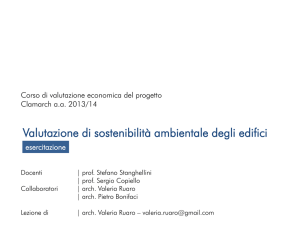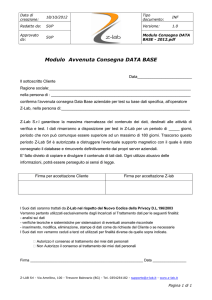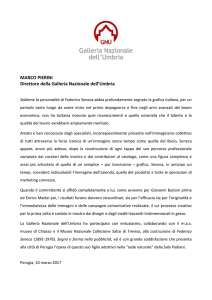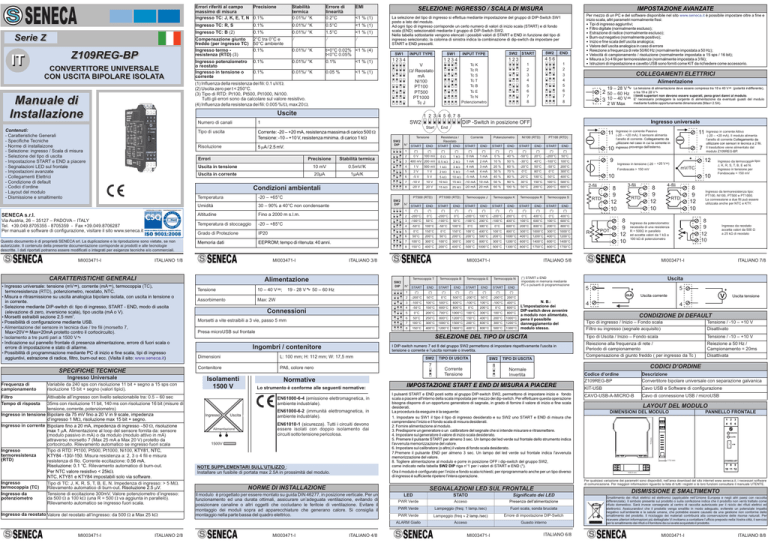
Serie
Serie Z
Z
IT
Z109REG-BP
Z109REG-BP
CONVERTITORE UNIVERSALE
CON USCITA BIPOLARE ISOLATA
Stabilità
termica
0.01%/ °K
Errore di
linearità
0.2°C
Ingresso TC: R, S
0.1%
0.01%/ °K
0.5°C
<1 % (1)
Ingresso TC: B (2)
0.1%
Compensazione giunto
freddo (per ingresso TC)
Ingresso termo resistenza (RTD) (3)
Ingresso potenziometro
o reostato
Ingresso in tensione o
corrente
2°C tra 0°C e
50°C ambiente
0.1%
0.01%/ °K
/
1.5°C
/
<1 % (1)
/
0.01%/ °K
0.1%
0.01%/ °K
t>0°C 0.02% <1 % (4)
t<0°C 0.05%
0.1%
<1 % (1)
0.1%
0.01%/ °K
0.05 %
SW1
SW1
INPUT TYPE
!!!"
"!!"
!"!"
""!"
!!""
"!""
!"""
""""
!!!!
V
"!!! !/ Reostato
!"!!
mA
""!!
NI100
!!"!
PT100
"!"!
PT500
PT1000
!""!
Tc J
"""!
Tipo di uscita
Corrente: -20 – +20 mA, resistenza massima di carico 500 !
Tensione: -10 – +10 V, resistenza minima. di carico 1 k!
Start
5 $A / 2.5 mV.
Errori
Precisione
Stabilità termica
10 mV
0.5mV/K
Uscita in tensione
Uscita in corrente
20µA
1µA/K
Condizioni ambientali
Temperatura
-20 – +65°C
30 – 90% a 40°C non condensante
Altitudine
Fino a 2000 m s.l.m.
Via Austria, 26 – 35127 – PADOVA – ITALY
Tel. +39.049.8705355 - 8705359 - Fax +39.049.8706287
Per manuali e software di configurazione, visitare il sito www.seneca.it
Temperatura di stoccaggio
-20 – +85°C
Grado di Protezione
IP20
Memoria dati
EEPROM; tempo di ritenuta: 40 anni.
ITALIANO 1/8
MI003471-I
CARATTERISTICHE GENERALI
termoresistenza (RTD), potenziometro, reostato, NTC.
! Misura e ritrasmissione su uscita analogica bipolare isolata, con uscita in tensione o
in corrente.
! Selezione mediante DIP-switch di: tipo di ingresso, START - END, modo di uscita
(elevazione di zero, inversione scala), tipo uscita (mA o V).
2
! Morsetti estraibili sezione 2.5 mm .
! Possibilità di configurazione mediante USB.
! Alimentazione del sensore in tecnica due / tre fili (morsetto 7,
Max=20V! Max=20mA protetto contro il cortocircuito).
! Isolamento a tre punti pari a 1500 V!
! Indicazione sul pannello frontale di presenza alimentazione, errore di fuori scala o
errore di impostazione e stato di allarme.
! Possibilità di programmazione mediante PC di inizio e fine scala, tipi di ingresso
aggiuntivi, estrazione di radice, filtro, burn-out ecc. (Visita il sito: www.seneca.it)
SPECIFICHE TECNICHE
Ingresso Universale
Variabile da 240 sps con risoluzione 11 bit + segno a 15 sps con
risoluzione 15 bit + segno (valori tipici).
Tensione
10 – 40 V!;"19 - 28 V! 50 – 60 Hz
Assorbimento
Max: 2W
Ingresso da reostato Valore del reostato all’ingresso: da 500#! a Max 25 k!
ITALIANO 2/8
!!!
!!"
!"!
!""
"!!
"!"
""!
"""
N° START
Resistenza /
Reostato
END
START
START
Potenziometro
END
START
END
NI100 (RTD)
Alimentazione
19 – 28 V!
La tensione di alimentazione deve essere compresa tra 10 e 40 V! (polarità indifferente),
o tra 19 e 28 V!
I Iimiti superiori non devono essere superati, pena gravi danni al modulo.
E' necessario proteggere la sorgente di alimentazione da eventuali guasti del modulo
mediante fusibile opportunamente dimensionato (Max= 2.5A).
2 50 – 60 Hz
3 10 – 40 V!
2 W Max
START
!!!
!!"
!"!
!""
"!!
"!"
""!
"""
PT100 (RTD)
END
START
END
(*)
(*)
(*)
(*)
(*)
(*)
(*)
(*)
(*)
(*)
(*)
(*)
0V
100 mV
0!
1 k!
0 mA
1 mA
0%
40 %
-50°C
20°C
-200°C
50°C
2 k!
1 mA
2 mA
10 %
50 %
-30°C
40°C
-100°C
100°C
3
4
400 mV 200 mV 0.5 k!
1V
500 mV 1 k!
5
2V
1V
3 k!
4 mA
3 mA
20 %
60 %
-20°C
50°C
-50°C
200°C
2 k!
5 k!
-1 mA
4 mA
30 %
70 %
0°C
80°C
0°C
300°C
6
-5 V
5V
5 k!
10 k!
-5 mA
5 mA
40 %
80 %
20°C
100°C
50°C
400°C
7
-10 V
10 V
10 k!
15 k!
-10 mA
10 mA
50 %
90 %
30°C
150°C
100°C
500°C
8
-20 V
20 V
15 k!
25 k!
-20 mA
20 mA
60 %
100 %
50°C
200°C
200°C
600°C
N° START
PT1000 (RTD)
END
START
END
Termocoppia J
START
Termocoppia K
END
START
END
Termocoppia R
START
END
START
(*)
(*)
(*)
(*)
(*)
(*)
(*)
(*)
(*)
(*)
(*)
-200°C
0°C
-200°C
0°C
-200°C
100°C
-200°C
200°C
0°C
400°C
0°C
400°C
3
-100°C
50°C
-100°C
50°C
-100°C
200°C
-100°C
400°C
100°C
600°C
100°C
600°C
4
-50°C
100°C
-50°C
100°C
0°C
300°C
0°C
600°C
200°C
800°C
200°C
800°C
5
0°C
150°C
0°C
150°C
100°C
400°C
100°C
800°C
300°C
1000°C
300°C
1000°C
6
50°C
200°C
50°C
200°C
200°C
500°C
200°C
1000°C
400°C
1200°C
400°C
1200°C
7
100°C
300°C
100°C
300°C
300°C
800°C
300°C
1200°C
600°C
1400°C
600°C
1400°C
8
150°C
400°C
200°C
400°C
500°C
1000°C
500°C
1300°C
800°C
1750°C
800°C
1750°C
Termocoppia B
END
START
END
Termocoppia E
START
START
END
1
(*)
(*)
(*)
(*)
(*)
(*)
(*)
(*)
2
-200°C
50°C
0°C
500°C
-200°C
50°C
-200°C
200°C
3
-100°C
100°C
500°C
600°C
-100°C
100°C
-100°C
400°C
4
-50°C
150°C
600°C
800°C
0°C
200°C
0°C
600°C
5
0°C
200°C
700°C
1000°C
100°C
300°C
6
50°C
250°C
800°C
1200°C
150°C
400°C
7
100°C
300°C
1000°C 1500°C
200°C
600°C
8
150°C
400°C
1200°C 1800°C
400°C
800°C
(*) START o END
impostato in memoria mediante
PC o pulsanti di programmazione
N. B.:
L'impostazione dei
DIP-switch deve avvenire
100°C 800°C
a modulo non alimentato,
200°C 1000°C pena il possibile
300°C 1200°C danneggiamento del
500°C 1300°C modulo stesso.
SELEZIONE DEL TIPO DI USCITA
I DIP-switch numero 7 ed 8 del gruppo SW2 permettono di impostare rispettivamente l'uscita in
tensione o corrente e l’uscita normale o invertita.
L: 100 mm; H: 112 mm; W: 17,5 mm
Contenitore
PA6, colore nero
SW2
7
!
"
Normative
Lo strumento è conforme alle seguenti normative:
EN61000-6-4 (emissione elettromagnetica, in
ambiente industriale).
EN61000-6-2 (immunità elettromagnetica, in
ambiente industriale).
EN61010-1 (sicurezza). Tutti i circuiti devono
essere isolati con doppio isolamento dai
circuiti sotto tensione pericolosa.
1500V
NOTE SUPPLEMENTARI SULL’UTILIZZO :
Installare un fusibile di portata max 2.5A in prossimità del modulo.
SW2
Corrente
Tensione
!
"
8
TIPO DI USCITA
IMPOSTAZIONE START E END DI MISURA A PIACERE
LED
STATO
Significato dei LED
PWR Verde
Acceso
Presenza dell’alimentazione
PWR Verde
Lampeggio (freq: 1 lamp./sec)
Fuori scala, sonda bruciata
PWR Verde
Lampeggio (freq & 2 lamp./sec)
Errore di impostazione DIP-Switch
ALARM Giallo
Acceso
Guasto interno
MI003471-I
Ingresso in tensione (-20 – +20 V!)
10
2-fili
R
10
3-fili
8
9
12
10
RTD
RTD
8
9
12
10
POT
12
mV/TC
Fondoscala > 150 mV
4-fili
8
9
12
10
RTD
8
9
12
10
Ingresso da termocoppia tipo:
J, K, R, S, T, B, E ed N.
Ingresso in tensione per
Fondoscala < 150 mV
Ingresso da termoresistenza tipo:
PT100, NI100, PT500 e PT1000.
La connessione a due fili può essere
utilizzata anche per NTC e KTY.
8
9
12
10
Ingresso da potenziometro:
necessita di una resistenza
R = 500Ω in parallelo
ed accetta valori da 1 kΩ a
100 kΩ di potenziometro
Ingresso da reostato
accetta valori da 500 Ω
a 25 kΩ di reostato
ITALIANO 7/8
MI003471-I
Uscita
5
+
mA
5
+
V
Uscita corrente
4
Uscita tensione
4
CONDIZIONE DI DEFAULT
Tipo di ingresso / Inizio – Fondo scala
Filtro su ingresso (segnale acquisito)
Tensione / -10 – +10 V
Disattivato
Tipo di Uscita / Inizio – Fondo scala
Tensione / -10 – +10 V
Reiezione alla frequenza di rete /
Periodo di campionamento
Compensazione di giunto freddo ( per ingresso da Tc )
Reiezione a 50 Hz /
Campionamento = 20ms
Disattivata
Codice d’ordine
Z109REG-BP
Descrizione
Convertitore bipolare universale con separazione galvanica
KIT-USB
Cavo USB e Software di configurazione
CAVO-USB-A-MICRO-B
Cavo di connessione USB / microUSB
LAYOUT DEL MODULO
DIMENSIONI DEL MODULO
PANNELLO FRONTALE
x PWR/ERR
x ALARM
Y
17,5 mm
USB
Z109REG-BP
100,0 mm
Per qualsiasi variazione dei parametri sono disponibili, nell’area download del sito internet www.seneca.it, i necessari software
di comunicazione. Per maggiori informazioni riguardo la lista di tutti i registri e le loro funzioni consultare il manuale UTENTE.
SEGNALAZIONI LED SUL FRONTALE
ITALIANO 4/8
7
Ingresso in corrente Attivo
(-20 – +20 mA). Il modulo alimenta
l’anello di corrente.Collegamento da
utilizzare con sensori in tecnica a 2 fili.
Il trasduttore viene alimentato dal
modulo Z109REG-BP.
CODICI D’ORDINE
Normale
Invertita
I pulsanti START e END posti sotto al gruppo DIP-switch SW2, permettono di impostare inizio e fondo
scala a piacere all'interno della scala impostata per mezzo dei dip-switch. Per effettuare questa operazione
bisogna disporre di un opportuno generatore di segnale, in grado di fornire il valore di inizio e fine scala
desiderati.
La procedura da eseguire è la seguente:
1. Impostare su SW1 il tipo il tipo di ingresso desiderato e su SW2 uno START e END di misura che
comprendano l’inizio e il fondo scala di misura desiderati.
2. Fornire alimentazione al modulo.
3. Predisporre un generatore o un calibratore del segnale che si intende misurare e ritrasmettere.
4. Impostare sul generatore il valore di inizio scala desiderato.
5. Premere il pulsante START per almeno 3 sec. Un lampo del led verde sul frontale dello strumento indica
l'avvenuta memorizzazione del valore.
6. Impostare sul calibratore (o altro) il valore di fondo scala desiderato.
7.Premere il pulsante END per almeno 3 sec. Un lampo del led verde sul frontale indica l'avvenuta
memorizzazione del valore.
8. Togliere alimentazione al modulo e porre in posizione OFF i dip-switch del gruppo SW2,
come indicato nella tabella SW2 DIP riga n°1 per i valori di START e END (*).
Ora il modulo è configurato per l’inizio e fondo scala richiesti; per riprogrammarlo anche per un tipo diverso
di ingresso è sufficiente ripetere l'intera operazione.
NORME DI INSTALLAZIONE
Il modulo è progettato per essere montato su guida DIN 46277, in posizione verticale. Per un
funzionamento ed una durata ottimali, assicurare un’adeguata ventilazione, evitando di
posizionare canaline o altri oggetti che occludano le feritoie di ventilazione. Evitare il
montaggio dei moduli sopra ad apparecchiature che generano calore. Si consiglia il
montaggio nella parte bassa del quadro elettrico.
MI003471-I
TIPO DI USCITA
11
+
ITALIANO 5/8
Termocoppia N
END
Ingresso in corrente Passivo
(-20 – +20 mA). Il sensore alimenta
l’anello di corrente. Collegamento da
utilizzare nel caso in cui la corrente in
ingresso provenga dall'esterno.
9
END
(*)
2
N° START
10
+
Termocoppia S
1
Termocoppia T
Dimensioni
Alimentazione
END
Corrente
MI003471-I
SW2
DIP
Ingombri / contenitore
Uscita
COLLEGAMENTI ELETTRICI
Ingresso universale
2
Presa microUSB sul frontale
Ingresso
1
2
3
4
5
6
7
8
1
ITALIANO 3/8
Connessioni
Filtro
Tempo di risposta
Attivabile all’ingresso con livello selezionabile tra: 0.5 – 60 sec
35ms con risoluzione 11 bit, 140 ms con risoluzione 16 bit (misure di
tensione, corrente, potenziometro)
Ingresso in tensione Bipolare da 75 mV fino a 20 V in 9 scale, impedenza
d’ingresso 1 M!, risoluzione max 15 bit + segno.
Ingresso in corrente Bipolare fino a 20 mA, impedenza di ingresso "50#!, risoluzione
max 1#$A.#Alimentazione al loop del sensore fornita da: sensore
(modulo passivo in mA) o da modulo (modulo attivo in mA)
attraverso morsetto 7 (Max 25 mA a Max 20 V) protetto da
cortocircuito. Rilevamento automatico se ingresso fuori scala
Ingresso
Tipo di RTD: Pt100, Pt500, Pt1000, Ni100, KTY81, NTC,
termoresistenza
KTY84 -130/-150. Misura resistenza a: 2, 3 o 4 fili e misura
(RTD)
resistenza di filo. Corrente eccitazione: 0.56 mA.
Risoluzione: 0.1 °C. Rilevamento automatico di burn-out.
Per NTC valore resistivo < 25k!.
NTC, KTY81 e KTY84 impostabili solo via software.
Ingresso
Tipo di TC: J, K, R, S, T, B, E, N. Impedenza di ingresso: > 5 M!%
termocoppia (TC)
Rilevamento automatico di burn-out. Risoluzione 2.5 $V.
Ingresso da
Tensione di eccitazione 300mV. Valore potenziometro d’ingresso:
potenziometro
da 500#! a 100 k! (una R = 500#!#va aggiunta in parallelo).
Rilevamento automatico se ingresso fuori scala.
Tensione
SW2
DIP
!!!
!!"
!"!
!""
"!!
"!"
""!
"""
Morsetti a vite estraibili a 3 vie, passo 5 mm
Isolamenti
1500 V
!!!
!!"
!"!
!""
"!!
"!"
""!
"""
1
2
3
4
5
6
7
8
11
SW2
DIP
Alimentazione
! Ingresso universale: tensione (mV!), corrente (mA!), termocoppia (TC),
!!!
!!"
!"!
!""
"!!
"!"
""!
"""
Tc K
Tc R
Tc S
Tc T
Tc B
Tc E
Tc N
Potenziometro
END
4 56
End
PT500 (RTD)
Umidità
Questo documento è di proprietà SENECA srl. La duplicazione e la riproduzione sono vietate, se non
autorizzate. Il contenuto della presente documentazione corrisponde ai prodotti e alle tecnologie
descritte. I dati riportati potranno essere modificati o integrati per esigenze tecniche e/o commerciali.
SW2
START
1 23
1 2 3 4 5 6 7 8
1
Risoluzione
SW2
INPUT TYPE
1 234
1234
Per mezzo di un PC e del software disponibile nel sito www.seneca.it è possibile impostare oltre a fine e
inizio scala, altri parametri normalmente fissi:
! Tipi di ingresso aggiuntivi;
! Filtro digitale (normalmente escluso);
! Estrazione di radice (normalmente escluso);
! Burn-out negativo (normalmente positivo);
! Inizio e fine scala dell’uscita analogica;
! Valore dell’uscita analogica in caso di errore
! Reiezione a frequenza di rete 50/60 Hz (normalmente impostata a 50 Hz);
! Velocità di campionamento / risoluzione (normalmente impostata a 15 sps / 16 bit);
! Misura a 3 o 4 fili per termoresistenze (normalmente impostata a 3 fili);
! Istruzioni di impostazione e cavetto USB sono forniti come KIT da richiedere come accessorio.
SW2#
!!!!!!!! DIP -Switch in posizione OFF
Numero di canali
SENECA s.r.l.
MI003471-I
<1 % (1)
IMPOSTAZIONE AVANZATE
SELEZIONE: INGRESSO / SCALA DI MISURA
La selezione del tipo di ingresso si effettua mediante impostazione del gruppo di DIP-Switch SW1
posto a lato del modulo.
Ad ogni tipo di ingresso corrisponde un certo numero di valori di inizio scala (START) e di fondo
scala (END) selezionabili mediante il gruppo di DIP-Switch SW2.
Nella tabella sottostante vengono elencati i possibili valori di START e END in funzione del tipo di
ingresso selezionato; la colonna di sinistra indica la combinazione di dip-switch da impostare per
START e END prescelti.
Uscite
Contenuti:
- Caratteristiche Generali
- Specifiche Tecniche
- Norme di installaizone
- Selezione: ingresso / Scala di misura
- Selezione del tipo di uscita
- Impostazione START e END a piacere
- Segnalazioni LED sul frontale
- Impostazioni avanzate
- Collegamenti Elettrici
- Condizione di default
- Codici d’ordine
- Layout del modulo
- Dismissione e smaltimento
Frequenza di
campionamento
<1 % (1)
(1) Influenza della resistenza dei fili: 0.1 uV/!%
(2) Uscita zero per t < 250°C.
(3) Tipo di RTD: Pt100, Pt500, Pt1000, Ni100.
Tutti gli errori sono da calcolare sul valore resistivo.
(4) Influenza della resistenza dei fili: 0.005 %/!, max 20 !%
Manuale di
Installazione
MI003471-I
EMI
112 mm
S SENECA
Errori riferiti al campo
Precisione
massimo di misura
Ingresso TC: J, K, E, T, N 0.1%
ITALIANO 6/8
DISMISSIONE E SMALTIMENTO
Smaltimento dei rifiuti elettrici ed elettronici (applicabile nell’Unione Europea e negli altri paesi con raccolta
differenziata). Il simbolo presente sul prodotto o sulla confezione indica che il prodotto non verrà trattato come
rifiuto domestico. Sarà invece consegnato al centro di raccolta autorizzato per il riciclo dei rifiuti elettrici ed
elettronici. Assicurandovi che il prodotto venga smaltito in modo adeguato, eviterete un potenziale impatto
negativo sull’ambiente e la salute umana, che potrebbe essere causato da una gestione non conforme dello
smaltimento del prodotto. Il riciclaggio dei materiali contribuirà alla conservazione delle risorse naturali. Per
ricevere ulteriori informazioni più dettagliate Vi invitiamo a contattare l’ufficio preposto nella Vostra città, il servizio
per lo smaltimento dei rifiuti o il fornitore da cui avete acquistato il prodotto.
MI003471-I
ITALIANO 8/8
Serie
Serie Z
Z
EN
Errors related to max
measuring range
TC input type: J, K, E, T, N
Accuracy
Thermal
stability
0.01%/°K
Linearity
error
0.2°C
EMI
0.1%
TC input type: R, S
0.1%
0.01%/°K
0.5°C
<1% (1)
TC input type: B (2)
0.1%
0.01%/°K
/
1.5°C
/
<1% (1)
/
Cold junction compensation 2°C from 0°C to
50°C environment
(for all TC inputs type)
Z109REG-BP
UNIVERSAL CONVERTER
WITH ISOLATED BIPOLAR OUTPUT
Thermoresistance
input type (RTD) (3)
0.1%
0.01%/°K
t>0°C 0.02% <1% (4)
t<0°C 0.05%
Potentiometer or rheostat
input type
0.1%
0.01%/°K
0.1%
<1%
Voltage or current input type 0.1%
0.01%/°K
0.05%
<1% (1)
(1) Influence of wire resistances: 0.1 uV/!
(2) Output zero if t < 250°C
(3) RTD type: Pt100, Pt500, Pt1000, Ni100
All the errors have to be calculated with reference to resistive value.
(4) Influence of wire resistances: 0.005 %/!, max 20 !
Installation
Manual
Channel numbers
Output type
SW1
Via Austria, 26 – 35127 – PADOVA – ITALY
Tel. +39.049.8705355 - 8705359 - Fax +39.049.8706287
Manuals and configuration software are available at www.seneca.it
This document is property of SENECA srl. Duplication and reprodution are forbidden, if not authorized.
Contents of present documentation refers to products and technologies described in it. All technical data
contained in the document may be modified without notice. This document is subject to periodical revision.
Thermal stability
0.5mV/K
1µA/K
thermoresistances RTD, potentiometer, rheostat, NTC.
or current.
! DIP-switch for selecting: type of input, START-END, output mode (zero elevation,
scale inversion), output voltage type (mA or V ).
2
! Removable terminals with section of 2.5 mm
! Possibility of USB configuration.
! Sensor powered by 2 / 3 wire technique is available: 20V! Max stabilised, 20mA Max
with short-circuit protection (terminal 7).
! 3-point insulation: 1500V!.
! Front panel indicating: power on, off scale or setting error and alarm status.
! Facility for programming the following through PC: START-END scale, additional input
types, square root extraction, filter, burn-out etc. (See: www.seneca.it)
TECHNICAL SPECIFICATIONS
Universal Input
Sampling
frequency
Filter
Variable from 240 sps with 11 bit + sign resolution
to 15 sps with 15 bit + sign resolution (tipical values).
The input signal filter level can be enabled and configured: from
0.5 to 60 sec.
Response time
35 ms with 11 bit resolution, 140 ms with 16 bit resolution ( for
measures: voltage, current and potentiometer)
Voltage input mode Bipolar from 75 mV to 20 V with 9 scales,
input impedance: 1 M!%#Max resolution 15 bit + sign.
Current input mode Bipolar up to 20 mA. Internal shunt "50#!. Max resolution 1#$A.
Powered sensor loop: from sensor to module (passive module) or
from module to sensor(actvive module) by terminal 7
(Max 25 mA! a Max 20 V!) with short-circuit protection.
Automatic input out of range detection.
RTD type: Pt100, Pt500, Pt1000, Ni100, KTY81, NTC,
KTY84 -130/-150. Resistance measure 2, 3 or 4 wires and
resistance wire measure. Energising current: 0.56 mA.
Resolution 0.1 °C. Automatic burn-out detection.
For NTC resistance value < 25k!.
NTC, KTY81 and KTY84 configurable only by software.
thermocouples (TC) TC type: J, K, R, S, T, B, E, N. Input impedance: > 5 M!%
input mode
Automatic burn-out’s detection. Resolution 2.5 $V.
Potentiometer input Excitation voltage of 300mV. Potentiometer input value
mode
from 500 ! to 100 k! (a R = 500#!#parallel circuit must be added).
Automatic input out of range detection.
Rheostat input
Input rheostat value: from 500#! to Max 25 k!
ENGLISH 2/8
!!!
!!"
!"!
!""
"!!
"!"
""!
"""
30 – 90% a 40°C not condensing
Altitude
Up to 2000m a.s.l.
StorageTemperature
-20 – +85°C
Protection degree
IP20
SW2
DIP
EEPROM for all configuration data; storage time: 40 years.
Voltage
10 – 40 V!;"19 - 28 V! 50 – 60 Hz
Consumption
Max: 2W
!!!
!!"
!"!
!""
"!!
"!"
""!
"""
N° START
END
1
2
3
4
5
6
7
8
Power supply
19 – 28 V!
The supply voltage must be between 10 to 40 V! (Any polarity) or between 19 e 28 V!.
The upper limits must not be exceeded to avoid serious damage to the module.
It’s necessary to protect the power supply source against any failure of the module using
appropriately sized fuse (Max = 2.5A).
2 50 – 60 Hz
3 10 – 40 V!
Universal input
1
2
3
4
(*)
START
(*)
(*)
0V
100 mV
0!
400 mV 200 mV 0.5 k!
1V
500 mV 1 k!
5
2V
1V
END
Current
Potentiometer
NI100 (RTD)
!!!
!!"
!"!
!""
"!!
"!"
""!
"""
PT100 (RTD)
START
END
START
END
START
END
START
END
(*)
(*)
(*)
(*)
(*)
(*)
(*)
(*)
0 mA
1 mA
0%
40 %
-50°C
20°C
-200°C
50°C
1 mA
2 mA
10 %
50 %
-30°C
40°C
-100°C
100°C
3 k!
4 mA
3 mA
20 %
60 %
-20°C
50°C
-50°C
200°C
Voltage input (-20 – +20 V!)
0°C
300°C
Full scale > 150 mV
5 k!
-1 mA
4 mA
30 %
70 %
0°C
80°C
(*)
5V
5 k!
10 k!
-5 mA
5 mA
40 %
80 %
20°C
100°C
50°C
400°C
10 V
10 k!
15 k!
-10 mA
10 mA
50 %
90 %
30°C
150°C
100°C
500°C
-20 V
20 V
15 k!
25 k!
-20 mA
20 mA
60 %
100 %
50°C
200°C
200°C
600°C
2-wire
Thermocouple J
Thermocouple K Thermocouple R Thermocouple S
RTD
START
START
START
END
END
END
START
END
START
(*)
(*)
(*)
(*)
(*)
(*)
(*)
(*)
(*)
(*)
(*)
(*)
2
-200°C
0°C
-200°C
0°C
-200°C
100°C
-200°C
200°C
0°C
400°C
0°C
400°C
3
-100°C
50°C
-100°C
50°C
-100°C
200°C
-100°C
400°C
100°C
600°C
100°C
600°C
4
-50°C
100°C
-50°C
100°C
0°C
300°C
0°C
600°C
200°C
800°C
200°C
800°C
5
0°C
150°C
0°C
150°C
100°C
400°C
100°C
800°C
300°C
1000°C
300°C
1000°C
6
50°C
200°C
50°C
200°C
200°C
500°C
200°C
1000°C
400°C
1200°C
400°C
1200°C
7
100°C
300°C
100°C
300°C
300°C
800°C
300°C
1200°C
600°C
1400°C
600°C
1400°C
8
150°C
400°C
200°C
400°C
500°C
1000°C
500°C
1300°C
800°C
1750°C
800°C
1750°C
N° START
END
START
END
START
END
Dimensions
L: 100 mm; H: 112 mm; W: 17,5 mm
Module box
PA6, black
START
END
(*)
(*)
(*)
(*)
(*)
(*)
(*)
(*)
2
-200°C
50°C
0°C
500°C
-200°C
50°C
-200°C
200°C
3
-100°C
100°C
500°C
600°C
-100°C
100°C
-100°C
400°C
4
-50°C
150°C
600°C
800°C
0°C
200°C
0°C
600°C
0°C
200°C
700°C
1000°C
100°C
300°C
100°C
800°C
6
50°C
250°C
800°C
1200°C
150°C
400°C
200°C
1000°C
7
100°C
300°C
1000°C 1500°C
200°C
600°C
300°C
1200°C
8
150°C
400°C
1200°C 1800°C
400°C
800°C
500°C
1300°C
SW2
7
!
"
Standards
(*) START or END
are set in memory with the PC or
with a programming push buttons.
Beware:
DIP-switches must be set
while the module is
powered down, otherwise,
the module may be
damaged.
EN61000-6-4 (electromagnetic emission,
industrial environment).
EN61000-6-2 (electromagnetic immunity,
industrial environment).
EN61010-1 (safety).
Power supply
1500V
ADDITIONAL NOTES:
One max 2.5A fuse must be installed near the module.
OUTPUT TYPE
SW2
Current
Voltage
!
"
8
The module is now configured for the required start and end scale.
To reprogram it (e.g. for a different type of input) repeat the whole procedure.
The module is designed to be installed, in vertical position, on DIN 46277 rail. For the best
module performance and long life, avoid to place cables raceways and other objects that
could obstruct ventilation slits.
Never install the modules near heat sources. We suggest to install the module in the bottom of
the control panel.
ENGLISH 4/8
8
9
12
10
RTD
Thermoresistance input type:
PT100, NI100, PT500 and PT1000.
The two-wire connection can also be
used for NTC and KTY
8
9
12
10
Potentiometer input:
One R = 500Ω resistance
parallel circuit is needed.
Potentiometer value must
be from1 kΩ to 100kΩ
Rheostat input:
values from 500 Ω to
25 kΩ are needed
ENGLISH 7/8
MI003471-E
Output
5
+
mA
5
+
V
Current output
4
Voltage output
4
DEFAULT CONDITIONS
Input type / Start – End range
Voltage / -10 V – +10 V
Input filter (acquired signal)
Output type / Start – End range
Disabled
Voltage / -10 V – +10 V
Reiection at mains frequency /
Sampling time
Cold junction compensation ( for RTc input)
Reiection = 50Hz /
Sampling time = 20ms
Disabled
Order code
Description
Z109REG-BP
KIT-USB
CAVO-USB-A-MICRO-B
Bipolar universal converter with galvanic separation
USB cable and configuration software
USB / microUSB cable
MODULE LAYOUT
MODULE DIMENSIONS
FRONT PANEL
x PWR/ERR
x ALARM
Y
USB
Z109REG-BP
17,5 mm
100,0 mm
Variations of standard parameters are possible by software (see www.seneca.it).
For more information about a list of all register and their function consult the USER manual.
FRONTAL LEDs INDICATIONS’S
LED
STATE
MEANING OF LEDS
PWR Green
On
Power supply presence
PWR Green
Flashing (freq: 1 Flash./sec)
Out of range, Burn Out
PWR Green
Flashing (freq & 2 Flash./sec)
DIP-Switch setting Error’s
ALARM Yellow
On
Internal fault
MI003471-E
RTD
8
9
12
10
PURCHASE ORDER CODE
Normal
Reversed
The START and END push-buttons under the SW2 DIP-switch group allow to set the beginning and end
scale at will within the scale pre-set through the dip-switches.
To obtain this facility it is necessary to use a suitable signal generator, able to furnish the desired values of
beginning and end scale.
The procedure is following:
1. Set to SW1 the type of input desired, set to SW2 a START and END measurement which include
the required beginning and end values.
2. Power up the module.
3. Supply a calibrator or simulator of the signal you wish to measure and re-transmit.
4. Set the required START value on the calibrator (or other instrument).
5. Press the START push-button for at least 3 sec.
The green LED on the front panel flashes to indicate the value has been stored.
6. Set the required END value on the calibrator (or other instrument)
7. Press the END push-button for at least 3 sec.
The green LED on the front panel flashes to indicate the value has been stored.
8. Cut power to the module and set to OFF position the dip-switches of group SW2,
Like in SW2 DIP frame: START and END values row n°1 (*).
INSTALLATION RULES
Thermocouple input type:
J, K, R, S, T, B, E and N.
Input voltage for
Full scale < 150 mV
OUTPUT TYPE
SETTING START AND END AT WILL
The module complies with the following standards:
POT
4-wire
8
9
12
10
ENGLISH 5/8
1
5
R
12
10
3-wire
8
9
12
10
END
1
Use this connection with 2 wire
measurement. The transducer is
powered by the module Z109REG-BP.
mV/TC
10
-5 V
-10 V
8
PT1000 (RTD)
+
9
+
7
END
7
current come from outside.
2 k!
2 k!
current input (-20 – +20 mA).
11 Active
The module supplies the current loop.
The sensor supplies the current loop.
1 k!
SW2 DIP-switches group numbers 7 and 8 enable you to set the output mode: voltage or current and
the output mode: normal or reversed.
Dimensions / Module box
10
6
N° START
Passive current input (-20 – +20 mA).
Use this connection if the input
SELECTION: OUTPUT TYPE
MI003471-E
ELECTRICAL CONNECTIONS
End
END
MicroUSB frontal plug
Output
!!!
!!"
!"!
!""
"!!
"!"
""!
"""
4 56
Thermocouple T Thermocouple B Thermocouple E Thermocouple N
Electrical connections
Input
SW2
1
2
3
4
5
6
7
8
MI003471-E
SW2
DIP
Removable 3-way screw terminals 5 mm pitch
Isolations
1500 V
START
1 23
ENGLISH 3/8
MI003471-E
Power supply
! Measurement and re-transmission on isolated analog bipolar output, with voltage output
!!!
!!"
!"!
!""
"!!
"!"
""!
"""
Resistance /
Rheostat
PT500 (RTD)
Humidity
GENERAL SPECIFICATIONS
! Universal input: voltage (mV!), current (mA!), thermocouples TC,
SW2
Tc K
Tc R
Tc S
Tc T
Tc B
Tc E
Tc N
Potentiometer
11
Voltage
SW2
DIP
-20 – +65°C
ENGLISH 1/8
INPUT TYPE
1 234
Start
Accuracy
10 mV
20 µA
Data Memory
!!!"
"!!"
!"!"
""!"
!!""
"!""
!"""
""""
SW2#
!!!!!!!! DIP -Switch in OFF position
Environmental conditions
SENECA s.r.l.
SW1
V
! / Rheostat
mA
NI100
PT100
PT500
PT1000
Tc J
2 W Max
5 µA / 2.5 mV.
Temperature
INPUT TYPE
1234
!!!!
"!!!
!"!!
""!!
!!"!
"!"!
!""!
"""!
1 2 3 4 5 6 7 8
Current: -20 – +20 mA, Maxium load resistance 500 !
Voltage: -10 – +10 V, minimum load resistance 1 k!
Resolution
MI003471-E
ADVANCED SETTINGS
By using a PC and downloadable softwares from www.seneca.it , it is possible to set other normally fixed
parameters in addition to start and end scale:
! Additional input types.
! Digital filter (normally disabled).
! Square root extraction (normally disabled).
! Negative burn-out (normally positive).
! Start and end scale of the analog output.
! Value of the analog output in case of error.
! Rejection programmable for 50 or 60 Hz mains frequency (normally set to 50 Hz).
! Sampling frequency/resolution (normally set to 15 sps/16 bit).
! 3 or 4 wires measure for thermal resistance (normally set to 3 wires).
! The instructions for setting and USB cable are supplied as a KIT available on request.
1
Errors
Voltage output
Current output
MI003471-E
SELECTION: INPUT / MEASURING SCALE
The type of input is selected by setting the SW1 DIP-Switches group at the side of the
module.
Each type of input is matched with a number of beginnings scale (START) and full scale
(END) selectables with the SW2 DIP-Switches group.
The frames above show the START or END values for every selected input.
Outputs
Contents:
- General specifications
- Technical specifications
- Installation rules
- Selection: input/ measuring scale
- Selection: output type
- Setting START and END at will
- Frontal LEDs indications’s
- Advanced settings
- Electrical connections
- Default conditions
- Purchase order codes
- Module layout
- Decommissioning and disposal
thermoresistances
(RTD) input mode
<1% (1)
112 mm
S SENECA
ENGLISH 6/8
DECOMMISSIONING AND DISPOSAL
Disposal of Electrical & Electronic Equipment (Applicable throughout the European Union and other European
countries with separate collections programs). This symbol, found on your product or on its packaging, indicates
that this product should not be treated as household waste when you wish to dispose of it. Instead, it should be
handed over to an applicable collection point for the recycling of electrical & electronic equipment. By ensuring this
product is disposed of correctly, you will help prevent potential negative consequences to the environment and
human health, which could otherwise be caused by inappropriate disposal of this product. The recycling of
materials will help to conserve natural resources. For more detailed information about the recycling of the product,
please contact your local city office, waste disposal service of the retail store where you purchased this product.
MI003471-E
ENGLISH 8/8

